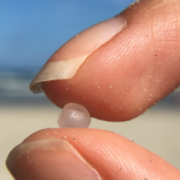- Xaris
- Jul 25, 2006
-

Lucky there's a family guy
Lucky there's a man who positively can do
All the things that make us
Laugh and cry
|
 I love EDCs - please keep us updated if there is any new/ interesting info in that book! I love EDCs - please keep us updated if there is any new/ interesting info in that book!
quote:Of particular concern for children and pregnant women are the many endocrine-disrupting chemicals, or EDCs, in plastics. Your endocrine system is a network of glands that secrete hormones: the pituitary gland and hypothalamus in your brain, the thyroid in your neck, the pancreas in your gut, the ovaries and testes. This network churns out estrogen, testosterone, melatonin, and insulin, among others, which together regulate your metabolism, growth, stress, sleep, and immune system. With out a functioning endocrine system, you can’t have a functioning body. Just one mishap somewhere in the system can lead to severe disease or death—consider how critical insulin therapy is to diabetics.
EDCs are a huge family of substances that assault this system, inter fering with the body’s hormones: of the 350,000 chemicals currently registered for production and use in industry, a thousand may have en docrine-disrupting properties, according to one conservative estimate, and a good many of those are in plastics. 75 Most EDCs have a similar structure to hormones, so they bind to receptors in the endocrine sys tem, preventing our own hormones from doing so or eliciting a response when there shouldn’t be one. (Some EDCs, particularly heavy metals like lead and mercury, still interfere with the endocrine system even though their structure is markedly different than hormones.) EDCs also interfere with enzymes the body uses to manufacture hormones, and with enzymes that should then be breaking down those hormones.
Health experts are particularly concerned about three classes of EDCs incorporated into the polymers we’re exposed to every day: bisphenols, phthalates, and PFAs
Bisphenols are most infamously represented by bisphenol A, or BPA, which is a synthetic estrogen but is also good for making hard, clear plastics like water bottles and other food and beverage containers. 76 “Unfortunately, it doesn’t just stay in plastics, because as those plastics get older or heated or washed, the plastic breaks down and BPA leaches out,” says Jodi Flaws, a reproductive toxicologist at the University of Illinois at Urbana-Champaign, who led a major 2020 report from the Endocrine Society on plastics and EDCs. Between 90 and 99 percent of people worldwide have BPA in their bodies. “We know from many studies now that it can affect brain development and behavior in both animal models and people,” says Flaws. “BPA exposure has been linked with anxiety and depression, hyperactivity, and attention and behavioral problems.” Same goes for polycystic ovarian syndrome and sexual dys function in men. “It’s been linked in human studies with breast cancers and prostate cancers, as well as some indication it might be linked with ovarian cancer and endometrial cancer.”
The FDA banned the use of BPA in baby bottles and sippy cups in 2012.78 But a study a few years later that tested 59 baby teethers dis covered that they all leached BPA, even though 48 of them were marketed as BPA-free.79 Bisphenols are also common in both synthetic and natural fibers, and in fact one experiment found much more in wool than polyester. 80 A 2021 investigation by the Center for Environmental Health discovered BPA in concentrations up to 31 times the safe limit in 84 sock brands for adults and infants, including Hanes, Fruit of the Loom, and Adidas. That’s especially unsettling given the Pig-Pen effect: the fabric is shedding when you walk around the house, thus contrib uting to the floor dust that infants crawl around in. That and BPA is easily absorbed through the skin.81 And the investigation just looked at socks—there’s no telling how much of our other clothing is laced with BPA, not to mention the synthetic sheets we sleep in. While everyone was worried about BPA in water bottles—and rightfully so—we’ve been wrapped in BPA the whole time.
Given the backlash against BPA, plastics producers have been switch ing it out for other bisphenols, like bisphenol S and bisphenol F, which haven’t been as well studied as BPA. The teethers study found BPS and BPF leaching out too. “So you’ll see like, Oh, BPA-free, but that does not mean it has not been replaced with something very similar in structure to BPA,” says Flaws. “We know some of those replacements are as toxic and maybe even more toxic, but a lot of them haven’t been studied.” And replacing BPA with BPS or BPF won’t magically eliminate humans’ exposure to BPA. Yes, if you’re drinking from a BPA-free water bottle you’re not drinking the chemical, at least if the manufacturer is being honest with you (and that’s a big if ).
But you’re still bombarded with legacy BPA: plastics companies began churning out polymers containing the chemical in the 1950s—by the late 1980s, production of BPA in the United States alone reached a billion pounds. 82 All the while, BPA-laced products have been shedding microplastics that blow across the land and swirl in the air and churn in the oceans. Even if production of BPA ceased tomorrow, the endocrine-disrupting chemical would still find its way into humans
Joining BPA and its ilk in their assault on the endocrine system are phthalates, plasticizers that give the material more flexibility. Plastics can be up to 60 percent phthalates by weight.83 Accordingly, indoor air is teeming with the chemicals, which researchers have found more in infants than adults. 84 Like bisphenols, phthalates disrupt the reproductive system and have been associated with reduced testosterone and estrogen levels—toxicologists have identified them as possible culprits in declining fertility among men and women.85 One study of 139 women found that the higher the phthalate levels in their blood, the more likely they were to develop postpartum depression.86 Studies have also linked phthalates to diabetes and heart problems.
Along with BPA, phthalates are obesogens, in that they increase obesity, and both are classified as metabolism-disrupting chemicals, or MDCs. Laboratory experiments on mice, for instance, show that ex posing them to microplastics makes their metabolism go haywire and reshuffles their gut microbiota. And scientists are investigating whether plastics have a role in the obesity pandemic: plotted together since the mid-1970s, the US obesity rate and plastic production increase in lockstep, just like with asthma rates. 87 Obviously there are many other contributors to obesity, like genetics and the proliferation of processed foods—wrapped in EDC-rich plastic, as it happens. But given that the number of obese people worldwide has tripled in just 50 years, which you can’t explain away with genetics, scientists are now scrutinizing plas tics as a potential contributor to the public health crisis. One team of researchers took common household items like food containers, plastic wrap, and shampoo bottles and extracted 11 different MDCs, including phthalates, which vigorously induced the development of fat cells in the lab.88 They also tested plastic flooring and found 10 of the 11 MDCs there too—the most of any of the products, actually—and remember Soltani’s finding that such a floor is a significant contributor to indoor microplastics. “Given the potency of the extracted mixtures and considering our close and constant contact with plastics,” the scientists wrote in a paper, “our results support the idea that plastic chemicals can con tribute to an obesogenic environment and, thus, the obesity pandemic.”
Beyond messing with metabolism, phthalates are bad news all around. “When you put that all together—something that’s associated with obesity, diabetes, and cardiovascular risks, not to mention all the other consequences—you have to take a step back and think, Well, gosh, is this associated with direct mortality?” asks Leonardo Trasande, an en vironmental health scientist at NYU Langone Health. To answer that question, Trasande analyzed health surveys from over 5,000 Americans who also provided urine samples to be tested for phthalates. He found that among 55to 64-year-olds, those with higher levels of phthalates used in food packaging were more likely to die of heart disease.89 “That’s independent of diet, physical activity, smoking—all of the usual suspects of causes that you might otherwise argue would explain what we found,” says Trasande. Scaling this up to the whole US population, he calculated that phthalate exposure may lead to between 91,000 and 107,000 pre mature deaths among older Americans each year. “We found this mor tality in the entirety of populations 20 and older, so we probably were being very conservative in that estimate,” says Trasande. “You have to ask yourself at some level, if this is causing so much disease and disability, why is it being used still? And that’s because there’s a cost to safer alter natives and companies likely profit from the use of these chemicals in plastic.”
Phthalates and BPA are similar in that they break down fairly fast, but that doesn’t make them any less of a threat to our health. “Even though we’re breaking down phthalates or BPA pretty quickly, we’re continu ously exposed, which is why we continuously have the chemicals in our bodies,” says Flaws. Again, eliminating these EDCs won’t magically rid our bodies and the world of them. Remember that as a microplastic particle breaks down, it’s continuously exposing fresh plastic at its core to whatever medium it’s in, or to whatever organism has ingested it— human or otherwise. “These microplastics are everywhere,” says Flaws. “And so what’s happening is we’re being constantly exposed.”
The third category of endocrine-disrupting chemical, though, is far more persistent than phthalates or BPA. More than 4,000 kinds of per and polyfluoroalkyl substances, or PFAS (scientists pronounce it PEA fass-iz—it’s an unwieldy plural acronym), are in use, making plastics and clothing waterand stain-resistant. One investigation found PFAS in three-quarters of products labeled as resistant to water and stains, including jackets, shirts, comforters, and tablecloths, all from major retailers.90 Another study even discovered high levels of the chemicals in anti-fogging sprays and cloths for eyeglasses.91 Not only are plastics loaded with PFAS, but microplastics gather PFAS already in the environ ment: one experiment found that particles that’d grown a plastisphere accumulated 85 percent more of the chemicals than pristine particles.92 “These are actually pretty scary compounds to me because they’re what we call ‘forever chemicals,’” says Flaws. “They really do not break down very well in the environment.” We’re talking lifespans of thousands of years.93 And PFAS are no less harmful than phthalates and bisphenols: toxicologists have shown them to disrupt the immune system and affect the liver and thyroid. They’re associated with reduced fertility and low birth weight and have also been linked to breast, ovarian, and testicular cancers, plus non-Hodgkin’s lymphoma.
What makes endocrine-disrupting chemicals even more insidious is how their dosing works. The old saying goes that the dose makes the poison: even aspirin is toxic if you eat enough of it. “But what we’ve learned from many hundreds of studies on endocrine-disrupting chem icals is their dose response is what we call non-monotonic, which basi cally means nonlinear,” says Flaws. So you’ll see a strong effect with a low dose, but this wanes with a moderate dose, before the effect rises again with a high dose. If you plotted this on a graph, with a low dose on one end and a high dose on the other, you’d get a U-shape for toxicity, not the linear line that indicates that a higher dose, and a higher dose alone, makes the poison.
You don’t need to consume much of an EDC, then, for it to have an effect. Indeed, researchers have found that small amounts of both BPA and BPS cause severe brain damage in goldfish, disrupting the signaling between nerve cells, which they note is highly likely to also happen in humans.94 (This also amplifies the concern that BPS and other alterna tives to BPA may be just as harmful, if not more so.) Toxicologists don’t yet fully understand the mechanisms at work here, but at low doses, an EDC could be binding to some receptors in the endocrine system and eliciting the response. “But if the dose gets too high,” says Flaws, “you might be shutting off, or down-regulating, those receptors, or shunting it to other receptors where there’s an ability to bind and elicit different responses. And in many ways, natural hormones work that way as well.” Low doses of estrogen, for example, bind to receptors, but as the dose increases, the receptors degrade until they switch off, a process known as receptor desensitization. Thus you don’t get a response at really high levels. “It’s not surprising that chemicals that mimic natural hormones could act in a very similar way,” says Flaws.
Mothers not only pass the harms of endocrine-disrupting chemicals on to their fetuses but on to even more distant generations. When a mother is exposed to EDCs, so too are her fetus’s germ cells, which develop into eggs or sperm. “It’s thought that during that exposure, the chemical can target those germ cells and do what we call repro gramming, or making epigenetic changes,” says Flaws. “That can be a permanent change that gets carried through generations, because those germ cells will eventually be used to make the next generation, and those fetuses will have abnormal germ cells that would then go on to make the next generation.” In the mid-20th century, scientists documented this in women who took a synthetic form of estrogen, called diethylstilbestrol or DES, to prevent miscarriages.95 The drug worked as intended, and the women gave birth to healthy babies. But once some of those children hit puberty, the girls developed vaginal and breast cancer. The boys de veloped testicular cancer, and some suffered abnormal development of the penis. Scientists called them DES daughters and sons. “When those DES daughters and sons had children, we now have DES granddaugh ters and grandsons, and a lot of them have increased risk of those same cancers and reproductive problems,” says Flaws. “Even though it was their great-grandmother that took DES—and they don’t have any DES in their system—their germ cells have been reprogramming, and they’re passing down some of these disease traits.”
And now toxicologists are gathering evidence that mothers are passing microplastics and nanoplastics—complete with EDCs and other toxic substances—to their fetuses. In 2021, scientists announced that they’d found microplastics in human placentas for the first time, both on the fetal side and maternal side. 96 Later that year, another team of research ers found the same, and they also tested meconium—a newborn’s first feces—and discovered microplastic there too. 97 Children are consuming microplastics, then, before they’re even born.
Beyond providing nutrients for the baby, the placenta manufactures a plethora of hormones critical for healthy growth. “It is very important to know what is happening during this early life stage, because we know it’s the most sensitive stage of human development,” says Hanna Dusza, a developmental toxicologist who’s studying microplastics at Utrecht University. “Any perturbation to these development processes can have quite big consequences for later health in an adult life. So it’s really, really important to be looking at that as well. And we have indication that indeed microplastics can pass the placenta and expose the develop ing fetus.” In the lab, Dusza grows placental cells and exposes them to microplastics and nanoplastics. She’s found that the cells uptake both sizes of particles, but nanoplastics much more so. Other scientists have injected nanoplastics into the tracheas of pregnant rats—it’s a more pre cise way to simulate inhalation because they know exactly how many particles the body’s absorbing—and detected the plastics in the fetuses’ hearts, lungs, and brains. 98 “I think nanoplastics, we’ll find out later on that they’re a bigger problem most probably, because they have a bigger surface area,” says Dusza. That means more opportunity to leach EDCs and other toxicants.
This is not the time to toy with a human’s development, especially with the hormones orchestrating it all. They stimulate fetal growth, initiate the differentiation of cell types—hair, muscle, blood—and control communication between a mother’s body and her child’s. As the youngster grows, the body passes through “windows of susceptibility,” as toxicologists like Dusza call it, in which different hormones play different roles. For instance, there’s a period when the limbs are developing, or when there’s increased brain development. It’s a miraculously well choreographed ballet that’s easily thrown into chaos by EDCs, which sci entists have already linked to cancers and lower IQs in children exposed in the womb. Later on in life, too, people who were exposed prenatally to EDCs are more likely to develop breast and ovarian cancer, and the chemicals have been linked to lower sperm quality. “We can already see that there could be a potential problem,” says Dusza. “What we don’t know yet is actually how many of these chemicals—and what those chemicals are—that are associated with plastic particles. So there’s still a big knowledge gap in actually distinguishing the particle toxicity and chemical toxicity. We know that it’s not only the particles that may cause the problem but also different chemicals leaching out of those particles.”
The issue is—again—that plastics manufacturers don’t disclose the ingredients in their products, which leaves the job to chemists to reverse-engineer the recipes. According to one estimate from researchers at ETH Zürich, at least 10,500 substances are used in plastics, and prob ably more in actual fact. (That study on MDCs in household plastics identified the signatures of 55,000 unidentified chemicals.) Of these, they identified over 2,400 as “substances of potential concern,” meaning they’re either persistent (like PFAS), bioaccumulative (the body can’t easily break them down), carcinogenic, or just straight-up toxic. 99 Half of these substances of potential concern aren’t regulated in the US, Eu rope, or Japan, but 900 of them are approved in those places for use in food-contact plastics. “It’s a huge variety of substances,” says environ mental chemist Zhanyun Wang, who did the tally. They include our usual suspects like heavy metals but also chemicals that are meant to replace toxic components of plastic but are themselves toxic. “This re grettable substitution is also happening,” says Wang. “Unfortunately, our current chemical regulatory system does not really require the man ufacturer to say that, OK, we’re replacing with this chemical, and this is the reason why.”
And the physical structure of microplastics can turn nonpersistent chemicals persistent. Phthalates, for example, degrade far faster than PFAS. But microplastics pack these chemicals in their core, so they aren’t initially exposed to the environment. “They can be a shield for more eas ily degradable chemicals,” says Wang. As the microplastic breaks apart, it sheds the toxicants at its core, releasing them into the surrounding medium, be it seawater or the human body. So even if a chemical isn't persistent on its own, packaged in a microplastic, it’s offered protection—a sort of slow-release poison pill.
Plastics in the Gut, Blood, and Brain
It’s a pill we’d rather not swallow. Analyses of human stool have turned up plenty of microplastics that pass through us, but the particles also seem to be getting stuck in the intestines. In one study, 11 patients in Malaysia who’d undergone colectomies—the removal of portions of the colon—provided tissue samples. 100 Nine of the patients had colon cancer and two did not. Researchers sifted through the samples and found an average of 800 microplastics per ounce of tissue. They noted the prevalence of transparent filaments, suggesting the digestive system bleached the particles, an indication that the colorants and other ad ditives in microplastics leach out in this hot and acidic environment, though this may instead be due to the fact that single-use plastic food wrappers tend to be clear, so the patients could have eaten already-trans parent microplastics. But in other lab experiments, scientists have shown both how microplastics greedily gather metals and then release them in a solution that mimics the chemistry of the human gut—the smaller the particle, the stronger this Trojan horse effect.101 It’s worth noting again that textile workers have increased rates of lung cancer and cancers of the digestive system—the mucociliary escalator brings particles out of the lungs to be swallowed.
Microplastics and their component chemicals might also pass through the gastrointestinal wall and into other tissues, the kind of translocation we’ve seen in fish. Our guts are lined with special cells that soak up nutri ents and pass them into the bloodstream, and immunologist Joost Smit of Utrecht University has shown that in mice at least, microplastics go along for the ride. He fed particles to the animals and then tested their blood, and the microplastics were there 10 minutes after they’d entered the rodent’s digestive system. Smit also found the particles in the livers of the mice. “It’s very low amounts of plastics, which can travel throughout the body after dosing, but they are there definitely,” Smit says. “Espe cially the smaller microplastics, but also the bigger microplastics, you can see them in the blood after you dose animals. And even the 10-mi crometer ones, which are quite large microplastics, they’re the size of half a cell basically, they still are transferred over the intestine.”
Sure enough, in 2022 scientists reported finding plastic particles in human blood samples for the first time. 102 Whether the pollutants had been absorbed through the gut or alveoli in the lungs wasn’t clear. Either way, by entering our bloodstreams and flowing to our organs, micro plastics may Trojan-horse whatever they’d accumulated while wandering around the environment. “They could be a kind of a vehicle of possibly dangerous substances that then get transferred in our body,” says Smit. “I think that’s the highest risk of these particles. Themselves they don’t seem to do much. But the stuff they carry, that might be a potential big risk.” Obviously our guts aren’t what you’d call a sterile environment— they’re teeming with all manner of bacteria and viruses, and indeed that microbial messiness helps our bodies absorb nutrients in the first place. “But the one thing which is kind of sterile is our blood in the body it self,” says Smit. “And of course, when a particle is loaded with bacteria, and it can cross the intestine and reach the bloodstream, it’s something which might trigger the immune system.”
Like the particles may act as nuclei in the atmosphere, collecting wa ter and ice, so too might they promote clotting in the bloodstream.103 “Obviously, your blood clotting in your body when you’re not bleeding is bad,” says Nathan Alves, a chemical and biomolecular engineer at the Indiana University School of Medicine who’s studying microplastics. Blood clots in the lungs and brain are particularly dangerous, but clots in the legs can also dislodge and flow to the lungs, where they cause pulmonary embolisms, which also kill. “When you stick something of reasonable size in the blood that starts attracting things, then you tend to aggregate. And once aggregation starts, it tends to be hard to stop until the blood stops flowing.” It’s a runaway train—made of blood. Around 8 percent of the population has some sort of variation in their blood that makes them more susceptible to coagulation. “I think in those kind of cases, when you add in an additional perturbation, like microplastic, you’re seeding more coagulation,” says Alves. “Maybe this is actually an underlying thing that’s happening more commonly clinically than we realize, but we’re not looking for it.” A big enough blockage somewhere in the body can make the heart overwork and fail. Or the heart will enlarge and maybe you survive, but now you have cardiac damage. “The other side of things is if you get a hugely massive exposure in your lungs to something, then the oxygen diffusion across the alveoli will drop,” says Alves. “And then you have less oxygenated blood coming into your body, and muscles like your heart might actually start to starve a bit. And you could cause cardiac damage.”
But back to the microorganisms on microplastics, because we’ve got fungi to worry about too. In Kenya, scientists discovered a horde of fun gal species growing and reproducing on soil microplastics, the core com munity of the plastisphere consisting of pathogens that infect plants, animals, and humans.104 “We found that certain pathogenic groups are concentrated on plastic, meaning that they’re in a higher concentration in the plastisphere compared to the soil,” says University of Bayreuth microbiologist Gerasimos Gkoutselis, who led the research. The most dominant fungi on the particles were nasties like Naganishia albida, a yeast that causes pneumonia, 105 and Rhodotorula, which is notorious for colonizing plastic equipment in hospitals, like catheters. “They re ally use plastic as an entrance point into the human body, for example during surgery,” says Gkoutselis. Once inside, Rhodotorula triggers seri ous infections. The concern isn’t just that microplastics could act as vehicles for de livering such pathogens into the human body but that they could be delivering them around the world. When winds loft microplastics into the atmosphere and carry them thousands of miles, that might transport pathogens “across boundaries, across biomes, and therefore transports the fungi to new habitats and enlarges their range,” says Gkoutselis. Many of these fungal pathogens are “opportunistic,” meaning that in the right conditions, a single species can infect either a plant or an animal, including humans. Microplastics could spread such nondiscriminatory menaces where they don’t belong.
To be clear, while we know microplastics are in our blood, scientists haven’t yet found them to transport anything dangerous from the out side world into our guts and then into the rest of our bodies. But Smit’s work shows that mice guts do absorb microplastic particles, and our guts probably do the same. And remember the extraordinarily high doses that infants get in their formula—a daily synthetic stew of millions of microplastics and trillions of nanoplastics that may be crossing the gas trointestinal barrier and moving through their developing bodies.
Even if microplastics just stuck around the digestive system, they might mess with our microbiomes both by introducing foreign species and by acting as platforms on which bacteria grow. Experiments with a machine that simulates a full human digestive system show that PET particles—in realistic concentrations we’re actually eating—had an anti bacterial effect, decreasing the number of viable bacteria and thus com promising the microbiome. 106 These bacterial species not only promote healthy digestion but also help maintain the immune function of the intestines and reduce inflammation by producing anti-inflammatory molecules. Intriguingly, a separate study found that subjects with in flammatory bowel disease, which may be caused by a malfunctioning immune system, had 50 percent more microplastics in their stool than healthy people.107 That’s not to say this proves microplastics cause IBD, though, as the disease may somehow make the gut retain more of the particles for scientists to find.108 But if microplastics are knocking out he bacteria that promote a healthy digestive system, that could be a causal link that demands more research.
A battery of other questions remains here. Might other gastrointesti nal issues, like celiac disease and lactose intolerance, change how micro plastics interact with the digestive system? Do the fat and fiber and sugar content of foods influence how the particles leach chemicals? And are microplastics staying in our bodies long enough to fragment into nano plastics, as they do in the guts of krill and earthworms? I’m not saying that our digestive systems are anything like that of a worm or planktonic crustacean, but if we’re also breaking down the particles, that’d mean microplastics that are too big to be absorbed through the gut degrade inside us into nanoplastics that can be.
What these nanoplastics might do to the human body, scientists are just beginning to investigate, but the implications aren’t great. In the remote Alps, millions of nanoplastics will fall on your head, but in your home, you’re surrounded by plastic in couches and carpets and sheets, all of them spewing particles that accumulate in dust and get kicked back into the air for you to breathe. And the smaller a particle gets, the more places it can squeeze into, physiologically speaking. We might even absorb them through our skin, particularly via hair follicles—that’s how small these things are. And that’s also why we need more research on whether the loads of plastics in cosmetics could be entering the body.
Scientists already have evidence of plastics readily moving through the human body. 109 Autopsies of 29 patients who’d received hip or knee replacements, made of metal and polyethylene, turned up traces of both materials in their lymph nodes, livers, and spleens. 110 Though the doc tors who wrote up the findings noted that in the majority of the patients “the concentration of wear particles in these organs was relatively low and without apparent pathological importance,” the prevalence of par ticles was greater in patients whose implants had failed. In one of these cases, small lumps of immune cells known as granulomas, which form due to infection or the presence of foreign objects, popped up in the liver, spleen, and lymph nodes “in response to heavy accumulation of wear debris from a hip prosthesis with mechanical failure.” The patient also had compromised liver function.
And then there’s the brain. Like fish, we have a blood-brain barrier that’s supposed to keep foreign objects out of the organ, but the littlest of particles can slip through. Scientists have long studied the effects of metal and metal-oxide nanoparticles—tiny bits of silver or gold or copper oxide—on the human body. “Several studies demonstrated that these particles can be taken up by our bodies and can actually reach the brain,” says Remco H. S. Westerink, a neurotoxicologist at Utrecht University.111 “Some of the particles can even damage the protective blood brain barrier, thereby facilitating their own entry as well as the entry of other unwanted chemicals. Notably, decreased blood-brain barrier function and neuroinflammation are also hallmarks of most neurode generative diseases.” Metal nanoparticles can even get taken up by nerve endings in the nose, thus bypassing the blood-brain barrier entirely. “Once in the brain,” Westerink adds, “these particles can have all kinds of effects, but the most predominant and adverse effect is the genera tion of oxidative stress, which damages the brain cells and can even kill them.” In severe cases, small parts of the brain are lost, and the organ begins to age faster, thereby speeding up degenerative diseases like Parkinson’s. But the effect depends on what the nanoparticles are made of: iron oxide, silver, and copper oxide are potent, whereas gold and titanium dioxide are more inert and cause less damage. “Nevertheless, if the exposure is sufficiently high, even these inert particles can still induce damage,” Westerink says. “So in the end, whether or not the exposure causes adverse health effects is determined by the degree of exposure.”
Do nanoplastics behave like metal nanoparticles in the human body, suffusing through our tissues and entering the brain? Another team of researchers confirmed that, indeed, mice fed fluorescent plastic particles smaller than two micrometers ended up with the foreign objects in their brains, so the stuff passed through the gut wall, into the blood, and then across the blood-brain barrier.112 Microglial cells—which remove damaged neurons and infections—recognized the particles as a threat and attacked them, but this significantly impacted the cells’ ability to proliferate, and in the end they perished. That means plastic particles are neurotoxic, at least in the brains of mice, but given that we’re also mam mals, there’s no reason to believe that little bits of plastic can’t do the same in our bodies. Indeed, in several other experiments, toxicologists have found that microplastics—in concentrations we’re already inhaling and eating—kill human cells grown in the lab.113 “Our preliminary data also indicates that plastic nanoparticles, and even microparticles, can reach the brain,” says Westerink. “While there is only very few data on plastics in the human brain, I don’t have much doubt that these particles can reach it. Whether or not the particles cause harm to the brain is a different question.”
That, again, comes down to exposure: are we eating and drinking and inhaling enough nanoplastics to have an effect? Only a fraction of metal and metal-oxide nanoparticles make it into the brain, and scientists are using high concentrations in lab experiments. But for practical pur poses, the experimental exposure is limited to hours, days, or months. “In real life, however, exposure is at lower levels, but it is continuous over an entire lifetime,” Westerink says. Your whole life you’ve been taking in microplastics and nanoplastics, and day by day, you’re exposed to more and more plastic as production accelerates and Earth’s natural systems grow increasingly plasticized. When, then, does the exposure become unsafe, if ever?
We can say with certainty that our brains would much rather avoid nanoplastics. Unlike a metal nanoparticle, a nanoplastic isn’t a single ele ment, but a suite of monomers, plasticizers, flame retardants, and on and on. “To make it worse, plastic particles undergo aging and weathering in the environment, which may affect their properties, and they can even adsorb different environmental chemicals,” says Westerink. “This results in literally an endless variation of different types of plastic particles.” Hell, a plastic particle that enters your body may have previously trav eled through the digestive system of some sea critter. For the time being, though, scientists don’t yet have evidence that microplastics and nanoplastics—at current concentrations in the envi ronment and in homes—harm human health. The stuff isn’t good for us, that’s for sure, and EDCs on their own are proven poisons of the highest order. But thus far the only clear harm is in textile workers and people exposed to PVC dust, who are in contact with way more particles than you and me, though finding microplastics in the malignant lung tissue of non–textile workers isn’t a good sign. Microplastics are in our bodies, that’s also for sure, but what they might be up to remains a big, frus trating unknown. 114 “The effects of microplastics on human health, we maybe know 1 percent of it,” says Smit. “We still don’t know 99 percent of what they might do, or actually what they might not do.” We humans are more sullied than any other animal on Earth. We spend our whole lives in contact with polymers, breathing and eating and drinking plastics, whereas a fish has to deal with what’s diffused into the environment. Which is a lot, but a fish doesn’t spend 90 percent of its life indoors huffing bits of clothes and carpets and couches. “I’m absolutely certain that using the right tools, we will find it in every part of the human anatomy, and that means it’s in every part of every animal on the planet,” says Steve Allen. “Now, as the levels go up, that’s the part that we don’t know about. Just how far does it have to go before we start having ecosystem collapse? I think that’s probably on the cards.” Xaris has issued a correction as of 21:39 on Nov 18, 2022
|


 I love EDCs - please keep us updated if there is any new/ interesting info in that book!
I love EDCs - please keep us updated if there is any new/ interesting info in that book!









































